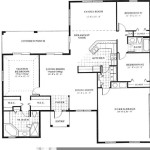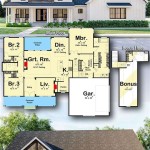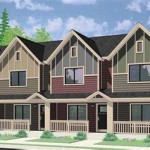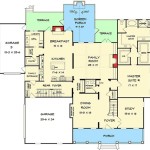Small House Plans: Ranch Style
Ranch-style homes, characterized by their single-story layout and horizontal design, have become a popular choice for homeowners seeking accessibility, convenience, and a connection to the outdoors. When considering smaller footprints, ranch plans offer unique advantages, effectively blending functionality with affordability. This article explores the design characteristics, benefits, and considerations involved in selecting small house plans in the ranch style.
The ranch style emerged in the United States during the mid-20th century, drawing inspiration from Spanish Colonial architecture. These homes are typically characterized by low-pitched roofs, open floor plans, attached garages, and large windows that emphasize indoor-outdoor living. The emphasis on simplicity and practicality contributed to the ranch's widespread appeal, making it adaptable to various climates and landscapes. The enduring popularity of ranch-style houses has resulted in a range of variations, including split-level, raised ranch, and modern adaptations that incorporate contemporary design elements.
Small ranch house plans are particularly appealing to first-time homebuyers, retirees, and individuals or small families seeking efficient living spaces. These plans offer a compelling blend of accessibility, affordability, and ease of maintenance, making them a practical choice for diverse lifestyles. A smaller footprint also translates to lower construction costs, reduced utility bills, and less time spent on upkeep, allowing homeowners to focus on other priorities.
Key Features of Small Ranch House Plans
Small ranch house plans retain the core characteristics of the ranch style while optimizing space for efficient living. Several features define these plans:
Single-Story Layout: The defining feature of the ranch style is its single-story design, eliminating the need for stairs and promoting accessibility for individuals of all ages and abilities. This layout also simplifies tasks such as carrying groceries, moving furniture, and cleaning, contributing to ease of living.
Open Floor Plan: Small ranch plans often incorporate an open floor plan that combines the living room, dining area, and kitchen into a single, unified space. This design maximizes the sense of spaciousness, promotes social interaction, and allows for flexible furniture arrangements. It also enhances natural light penetration, creating a brighter and more inviting atmosphere.
Attached Garage: An attached garage is a common feature of ranch-style homes, providing convenient and secure parking while also offering additional storage space. In smaller plans, the garage may be integrated into the overall design to minimize the visual impact and maintain a cohesive aesthetic.
Large Windows and Sliding Doors: Ranch homes are known for their large windows and sliding doors that connect the interior spaces with the outdoors. These features maximize natural light, provide ventilation, and create a seamless transition between indoor and outdoor living areas. Decks, patios, and landscaping are often incorporated to extend the living space and enhance the connection with nature.
Low-Pitched Roof: A low-pitched roof is a characteristic element of the ranch style, contributing to its horizontal profile and minimizing wind resistance. The roof overhangs can provide shade and protection from the elements, while also adding architectural interest to the exterior.
Benefits of Choosing a Small Ranch House Plan
Selecting a small ranch house plan offers a variety of benefits that appeal to a wide range of homeowners:
Accessibility: The single-story layout of ranch homes makes them ideal for individuals with mobility limitations, families with young children, and seniors seeking aging-in-place solutions. The absence of stairs eliminates the risk of falls and allows for easy navigation throughout the home.
Affordability: Small ranch plans are generally more affordable to build and maintain than larger, multi-story homes. The reduced square footage translates to lower construction costs, reduced energy consumption, and lower property taxes. This makes them an attractive option for first-time homebuyers and those seeking a budget-friendly housing solution.
Ease of Maintenance: The simple design and single-story layout of ranch homes simplify maintenance tasks such as cleaning, painting, and roof repairs. The absence of stairs and multiple levels reduces the physical effort required for upkeep, making them a practical choice for busy homeowners.
Indoor-Outdoor Living: Ranch homes are designed to maximize the connection between indoor and outdoor spaces. Large windows, sliding doors, and patios encourage residents to enjoy the natural surroundings and create a seamless transition between the interior and exterior living areas. This enhances the overall quality of life and promotes a sense of well-being.
Customization: Despite their relatively simple design, ranch homes can be easily customized to reflect the homeowner's individual preferences and lifestyle. Interior spaces can be adapted to create functional and stylish living areas, while exterior features such as landscaping, paint colors, and architectural details can be modified to enhance the curb appeal and personalize the overall look.
Energy Efficiency: Small ranch homes are inherently more energy-efficient than larger homes due to their compact design and reduced surface area. Proper insulation, energy-efficient windows, and modern HVAC systems can further enhance energy efficiency, resulting in lower utility bills and a reduced environmental impact. Single story construction also minimizes heat loss through the roof.
Considerations When Selecting a Small Ranch House Plan
While small ranch house plans offer numerous advantages, it is important to consider several factors when choosing a plan that meets your specific needs and preferences:
Lot Size and Orientation: The size and orientation of your building lot will influence the design and placement of your ranch home. Consider the sun's path, prevailing winds, and drainage patterns when determining the optimal location for the home on the lot. A well-oriented home can maximize natural light, minimize heat gain during the summer, and provide protection from the elements.
Space Planning: Careful space planning is essential to maximize the functionality and comfort of a small ranch home. Consider the flow of traffic between rooms, the placement of furniture, and the storage needs of your household. Open floor plans can create a sense of spaciousness, while strategically placed partitions can provide privacy and define distinct living areas. Multipurpose spaces that can adapt to different needs are particularly valuable in smaller homes.
Storage Solutions: Storage space is often at a premium in small homes, so it is important to incorporate creative storage solutions into the design. Built-in shelves, cabinets, and drawers can maximize storage capacity without taking up valuable floor space. Utilizing vertical space with high shelves and organizational systems can also help to keep the home clutter-free.
Accessibility Features: If accessibility is a primary concern, consider incorporating universal design principles into the plan. Wider doorways, barrier-free showers, and grab bars can enhance accessibility for individuals with mobility limitations. Ramps can be used to provide access to the home's entrance and outdoor living areas.
Future Expansion: While the goal is a small home, consider the potential for future expansion if your needs may change over time. Adding an addition or finishing an unfinished basement can provide additional living space without requiring a complete renovation. Planning for future expansion during the initial design phase can simplify the process and minimize costs.
Local Building Codes and Regulations: Ensure that your chosen house plan complies with all applicable local building codes and regulations. This includes zoning ordinances, setback requirements, and energy efficiency standards. Consulting with a local building official or architect can help to ensure that your plan meets all necessary requirements.
When selecting a small ranch house plan, evaluating online resources and customizable plans offers a broad spectrum of designs. There are many online resource that offer pre-designed ranch house plans that can be modified to suit your particular needs. These platforms often provide 3D renderings, floor plans, and material lists, allowing you to visualize the finished product and estimate the construction costs. It is also possible to work with an architect or designer to create a custom plan that is tailored to your specific requirements and preferences.
In summary, small ranch house plans offer a compelling combination of accessibility, affordability, and ease of maintenance, making them an attractive option for a wide range of homeowners. By carefully considering the key features, benefits, and considerations outlined in this article, you can select a plan that meets your specific needs and creates a comfortable and functional living space.
Ranch House Plan 2 Bedrms 1 Baths 768 Sq Ft 157 1451

Ranch Home 1 Bedrm 5 Baths 904 Sq Ft Plan 141 1325

Small Ranch House Plan Two Bedroom Front Porch 109 1010 Style Plans Cottage Homes

Ranch Style 2 Bedroom House Plan 943 Sq Feet Or 87 6 M2

Plan 80523 2 Bedroom Small House With 988 Square Feet

Small House Plans Simple Floor Cool

Tiny Ranch Home 2 Bedroom 1 Bath 800 Square Feet

Simple Affordable Ranch Home Design Style House Plans Homes

10 Small House Plans With Open Floor Blog Homeplans Com

10 Small House Plans With Open Floor Blog Homeplans Com








